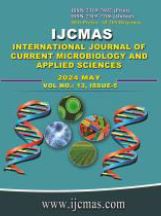


 National Academy of Agricultural Sciences (NAAS)
National Academy of Agricultural Sciences (NAAS)

|
PRINT ISSN : 2319-7692
Online ISSN : 2319-7706 Issues : 12 per year Publisher : Excellent Publishers Email : editorijcmas@gmail.com / submit@ijcmas.com Editor-in-chief: Dr.M.Prakash Index Copernicus ICV 2018: 95.39 NAAS RATING 2020: 5.38 |
Globally diarrhoea remains the second leading cause of death in children. Among the etiology, bacterial pathogens diarrheagenic Escherichia coli (DEC) is important etiological agents. Most DEC produce a large outer membrane protein intimin encoded by eaeA gene which is the genetic determinant of the formation of attaching/effacing (A/E) lesion, a central mechanism in the pathogenesis and strains containing eaeA are categorized as enteropathogenic Escherichia coli (EPEC). EPEC is a cause of broad-spectrum gastrointestinal infections among humans and animals, especially in developing countries. Severe EPEC infections can lead to death. This study was intended to detection of EPEC and its antibiotic sensitivity patterns from diarrheic children and environment of Surat, Gujarat, India during 2021-2023. Total of 252 stool, 334 food and 379environs samples were processed for the detection of EPEC. Primary isolation of E. coli using microbiological technique were followed by Polymerase Chain Reaction-duplex PCR for genus specific 16SrRNA and eaeA genes. Antibiogram were determined by Kirby-Bauer test for 24 antimicrobial agents. In this study, 184 (73.03%) from diarrheic stool, 171 (51.32%) from food and 225 (59.12%) from environ samples were confirmed as E. coli. Overall prevalence of EPEC among the examined samples was 2.58% (n= 15/580). Highest susceptibility of the EPEC isolates was found against Gentamicin, Amikacin, Ofloxacin, Meropenem (100%) and 73.3%were distinct as multi-drug resistant (MDR). In conclusion, the emergence of MDR-EPEC from environ sources is a public health concern. E. coli (including EPEC) isolates are important inter- and intraspecies disseminators of antimicrobial resistance.
Abbasi, P., Kargar, M., Doosti, A., Mardaneh, J., Ghorbani-Dalini, S. and Dehyadegari, M. A., 2014. Characterization of Shiga-toxin producing E. coli (STEC) and enteropathogenic E. coli (EPEC) using multiplex Real-Time PCR assays for stx1, stx2, eaeA. Iranian journal of microbiology, 6(3), p.169.
Clinical and Laboratory Standards Institute (CLSI), 2017. Performance standards for Antimicrobial Susceptibility Testing; 27th ed. Informational supplement M100S-Ed27.
Clinical and Laboratory Standards Institute (CLSI), 2022. Performance Standards for Antimicrobial Susceptibility Testing; 32nd ed. informational supplement M100-Ed32.
CLSI, 2009
Darshan D. Patel, Murtaza A. Hajoori and Jignaben P. Naik, 2023. Detection of Shiga Toxin Producing Escherichia coli (STEC) O157-A Food and Waterborne Zoonotic Pathogens as Implications of One Health Perspective. Biological Forum – An International Journal, 15(5a), pp. 640-646.
EUCAST, 2008
Islam, M. M., Ahamed, S., Arafat, M. Y., Hasan, I., Rahman, M. and Nazir, K. H. M. N. H., 2016. Molecular detection and antibiogram of shiga toxin producing Escherichia coli (STEC) isolated from diarrheic children. Bangladesh Journal of Veterinary Medicine, 14(2):289. https://doi.org/10.3329/bjvm.v14i2.31411.
Kaper, J. B., 1996. Defining EPEC. Reviews in Microbiology Sao Paulo, 2(7), pp. 130–133.
Kaper, J. B., Nataro, J. P. and Mobley, H. L., 2004. Pathogenic Escherichia coli. Nature reviews microbiology, 2(2), pp.123-140. https://doi.org/10.1038/nrmicro818
Keskimäki, M., Eklund, M., Pesonen, H., Heiskanen, T. and Siitonen, A., 2001. EPEC, EAEC and STEC in stool specimens: prevalence and molecular epidemiology of isolates. Diagnostic Microbiology and Infectious Disease, 40(4), pp.151-156. https://doi.org/10.1016/S0732-8893(01)00265-6
Lanata, C. F., Mendoza, W. and Black, R. E., 2002. Improving diarrhoea estimates. Geneva, Switzerland: World Health Organization.
Meng, J., Zhao, S., Doyle, M. P., Mitchell, S. E. and Kresovich, S., 1997. A multiplex PCR for identifying Shiga?like toxin?producing Escherichia coli O157: H7. Letters in Applied Microbiology, 24(3), pp.172-176. https://doi.org/10.1046/j.1472-765x.1997.00375.x
Nataro, J. P. and Kaper, J. B., 1998. Diarrheagenic Escherichia coli. Clinical microbiology reviews, 11(1), pp.142-201. https://doi.org/10.1128/CMR.11.1.142
Paton, J. C. and Paton, A. W., 1998. Pathogenesis and diagnosis of Shiga toxin-producing Escherichia coli infections. Clinical microbiology reviews, 11(3), pp.450-479. https://doi.org/10.1128/cmr.11.3.450
Robins-Browne, R. M., 1987. Traditional enteropathogenic Escherichia coli of infantile diarrhea. Clinical Infectious Diseases, 9(1), pp.28-53. https://doi.org/10.1093/clinids/9.1.28
Schmidt, M. A., 2010. LEE ways: tales of EPEC, ATEC and EHEC. Cellular microbiology, 12(11), pp.1544-1552. https://doi.org/10.1111/j.1462-5822.2010.01518.x
Subramanian, K., Selvakkumar, C., Vinaykumar, K. S., Goswami, N., Meenakshisundaram, S., Balakrishnan, A. and Lakshmi, B. S., 2009. Tackling multiple antibiotic resistance in enteropathogenic Escherichia coli (EPEC) clinical isolates: a diarylheptanoid from Alpinia officinarum shows promising antibacterial and immunomodulatory activity against EPEC and its lipopolysaccharide-induced inflammation. International journal of antimicrobial agents, 33(3), pp.244-250. https://doi.org/10.1016/j.ijantimicag.2008.08.032
Tamura, K., Sakazaki, R., Murase, M. and Kosako, Y., 1996. Serotyping and categorisation of Escherichia coli strains isolated between 1958 and 1992 from diarrhoeal diseases in Asia. Journal of medical Microbiology, 45(5), pp.353-358.
Taneja, N., Rao, P., Arora, J. and Dogra, A., 2008. Occurrence of ESBL & Amp-C β-lactamases & susceptibility to newer antimicrobial agents in complicated UTI. Indian Journal of Medical Research, 127(1), pp.85-88.
Vandepitte, J., 2003. Basic laboratory procedures in clinical bacteriology. World Health Organization (WHO).
Vijayan, C., Ajaykumar, V. J., Bhattacharya, A. and Bhanurekka, V., 2017. Detection of enterohaemorrhagic E. coli O157: H7 from beef and chevon sold in and around Puducherry. Journal of Entomology and Zoology Studies, 5(6), pp.1395-1403.
 |
 |
 |
 |
 |